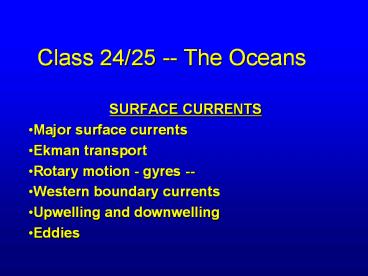Class 24/25 -- The Oceans - PowerPoint PPT Presentation
1 / 39
Title:
Class 24/25 -- The Oceans
Description:
Class 24/25 -- The Oceans SURFACE CURRENTS Major surface currents Ekman transport Rotary motion - gyres -- Western boundary currents Upwelling and downwelling – PowerPoint PPT presentation
Number of Views:119
Avg rating:3.0/5.0
Title: Class 24/25 -- The Oceans
1
Class 24/25 -- The Oceans
- SURFACE CURRENTS
- Major surface currents
- Ekman transport
- Rotary motion - gyres --
- Western boundary currents
- Upwelling and downwelling
- Eddies
2
MAJOR SURFACE CURRENT SYSTEMS
- Driving force global winds
- Trade Winds Westerlies
- Deflected by continents and Coriolis effect
- System of E-W currents (wind-driven) and
- N-S "boundary"currents (deflection)
3
(No Transcript)
4
(No Transcript)
5
(No Transcript)
6
(No Transcript)
7
Ekman Transport In which direction is water
moved when the winds blows across its surface?
1) Coriolis effect Motion of the uppermost
layer is deflected to the right of the winds
force
8
- 2) Now consider the next layer deeper
- Motion slower than upper layer
- Force from upper layer is at 45 degrees to the
wind - Coriolis effect deflects motion relative to THAT
direction
9
- 3) Successive deeper layers
- Same idea again- and speed keeps decreasing with
depth
10
- 4) What is the overall motion (average for the
entire depth affected by the wind)? Walfrid
Ekman did the math...
Ekman Transport- Perpendicular to Wind
Direction!!!!
Ekman Spiral
11
(No Transcript)
12
Ekman Transport The overall movement of water
is PERPENDICULAR to the wind direction!!!!!!!
13
A Detailed Look at the Gyres
- 1. Ekman transport tends to force water into the
gyre - This creates a subtle "hill or mound of water.
14
(No Transcript)
15
(No Transcript)
16
(No Transcript)
17
North-South currents- Details
- Currents on the western sides
- Strong, narrow, deep
- Example The Gulf Stream
18
North-South currents- Details
- Currents on the eastern sides
- Slow, broad, shallow
- Canary Current- Eastern Atlantic
19
Why are currents more intense on the western
sides?
1. Trade winds compress currents against
continents there 2. Coriolis effect is greater at
higher latitudes
20
UPWELLING AND DOWNWELLING INDUCED BY EKMAN
TRANSPORT
Ekman transport can drive surface waters 1.
apart, --gt upwelling 2. together --gt
downwelling 3. away from coasts --gt
upwelling 4. toward coasts --gt downwelling
21
CONVERGENCE
22
(No Transcript)
23
(No Transcript)
24
(No Transcript)
25
(No Transcript)
26
NORTHWESTERN U.S.
27
(No Transcript)
28
(No Transcript)
29
Regions of upwelling and downwelling
- Equatorial upwelling in the open ocean
- Antarctic Divergence Zone
- Coastal upwelling- west sides of continents (esp.
South America and Africa) - Seasonal upwelling and downwelling along some
coasts due to seasonal wind changes (e.g.,
California) - Upwelling Nutrients!
30
(No Transcript)
31
Equatorial Upwelling
32
(No Transcript)
33
(No Transcript)
34
EDDIES IN SURFACE CURRENTS
- At edges of currents
- Rings of rotating water, 10-100 km wide
- Example In the Gulf Stream
- Cold/Water boundary has curves
- Curves get increasingly pronounced- big loops
- Eddies become pinched-off
35
(No Transcript)
36
(No Transcript)
37
Eddies, Contd
- Waters in eddies have different temperature,
salinity, etc. - Rotary motion in eddies can extend to great depths
38
(No Transcript)
39
(No Transcript)































